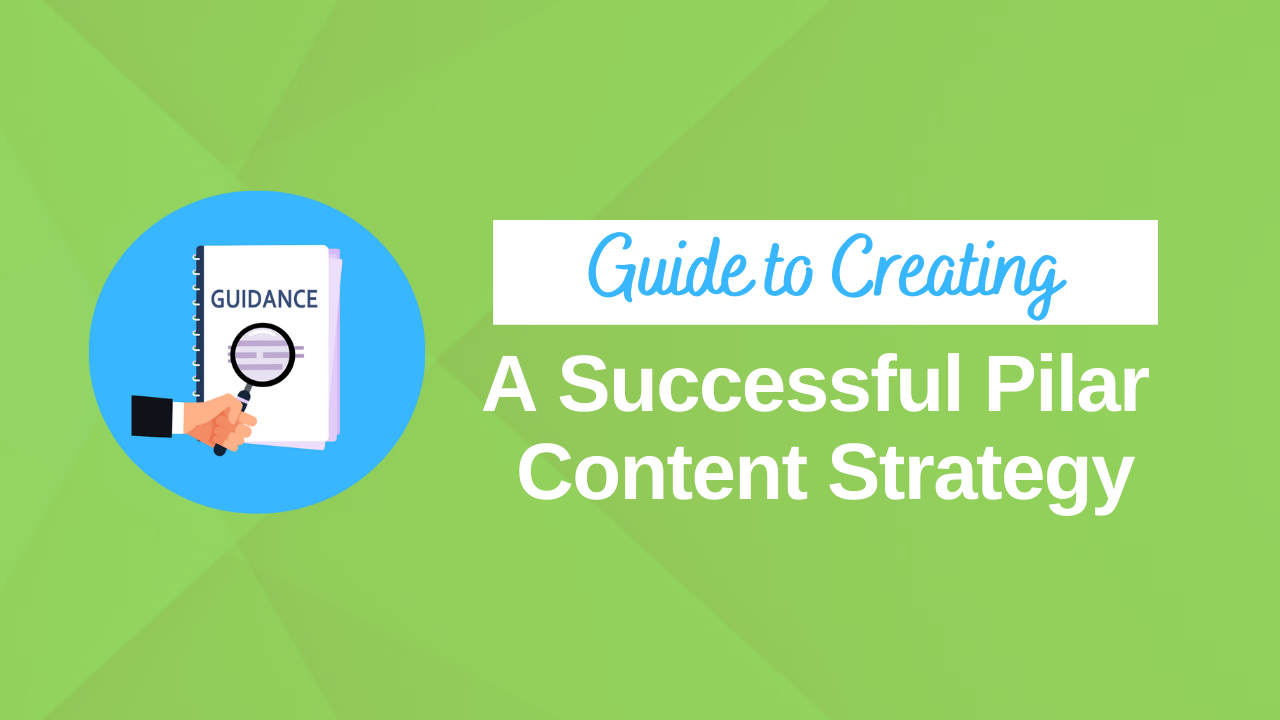
Guide to Creating a Successful Pillar Content Strategy
According to Dragon Search Marketing, 61% of consumers make their buying decisions based on custom content.
It’s no secret, humanity is at the dawn of the content era.
And in this new era, pillar content has become a buzzword.
So much so, that some of my clients weren’t taking it seriously at first, considering it a fad.
Yet, pillar content is anything but. Creating content pillars is becoming more important than ever because it is key to a successful SEO strategy.
That’s right.
In the content era, building a strong pillar content strategy is critical for any business wishing to rank higher in search engines.
That’s why I’ve decided to cover in detail what pillar content is, why it’s important and how to create a powerful pillar content strategy.
What Is Pillar Content?
Pillar content refers to content that provides an exhaustive answer to any question a reader may have. It’s usually organised around a key theme. And can be found on a “pillar” page.
A pillar page is designed to broadly cover a single topic. And contains all of the information a reader needs to know.
But how can one page contain everything someone needs to know?
Well, a pillar page typically links to other pages (or cluster blog posts) that hyperlink back to the pillar page. And these cluster blog posts each dive deep into subtopics that support the main pillar content.
The comprehensive nature of this content makes it high-value to your readers. Plus, it also allows creators to rank higher in search engines. That’s because the broad aspect of the content covered on a pillar page makes it highly linkable, which is terrific for SEO purposes. But more on this in the next section.
Pillar Page Example
Here’s one of my favorite pillar content examples:
Let’s say you own a travel agency. One of your content pillars is ‘’travelling in Australia’’. Your pillar page should contain an overview of the topic and link to subtopics (or topic clusters). These should cover everything travellers need to know to plan their trip Down Under.
For instance, some of the topic clusters to cover the broader topic could be:
How to travel in Australia on a budget?
Top 20 things to pack for a trip to Australia
Best cities to explore in Australia
Best hotels in Australia
Top 10 things to do in Australia
Top Benefits of Pillar Content
Boost Your Site’s Rankings
Creating pillar pages and subtopics (or topic clusters) is great for SEO.
Why?
Because creating exhaustive content around a key theme sets you up as the one-stop-shop for everything to know about a particular topic. It also allows you to answer all of the questions a user might have about a subject, prompting Google to rank your content for related search queries.
But that’s not all.
The higher quality content you share around a specific topic, the longer readers will spend on your site. They’ll visit other pages and read more content, signalling Google that your website features high-quality content that answers users’ questions.
And this in turn, encourages search engines to rank your website higher when a user types a search query relevant to your niche or area of expertise.
Power Your Content Strategy
Many of my clients mention how challenging the content ideation process can be.
Well, if you’ve ever found yourself wondering where to start, here’s the great news: defining content pillars will make content creation much easier and more efficient.
Once you've chosen a key theme for your pillar content, you then have subtopics that will fit in as regular blog post content as well.
For instance, using the example above of "travelling in Australia," you can come up with content ideas using simple association.
If you look at "hotels in Australia," you can brainstorm blog post ideas such as:
- Cheapest hotels in Australia
- Quirkiest Hotels in Australia
And more as well.
This takes very little brainpower, and even beginner writers can nail this tactic.
Even better, by branching out like this, you can fill up a content calendar in no time at all.
Establish Yourself As An Authority
Crafting content around core themes shows readers your expertise and helps build trust with your audience.
What’s more, by consistently publishing compelling content around a specific theme or topic, you’ll rank higher on search engines. This will help potential customers, other brands, and content creators in your industry, find you online.
And as they create content, they’re likely to mention your high-quality resources and link back to your website, asserting you as an authority in your field.

Establish Yourself As An Authority
How To Create a Pillar Content Strategy?
Choose a Topic
The first step to creating a successful pillar content strategy is to define your topic. Finding a core topic is extremely important to establish your authority.
How to Find a Theme for Your Content Strategy?
Not only do you need to be an expert on the topic, but it also needs to address your audience’s needs. So, you should study your market’s pain points as it’ll help you find the perfect theme.
What’s more, to find your main content pillars, don’t go too granular as your pillar page should broadly cover the topic and link to supporting blog posts for more details. However, don’t choose a topic that’s too broad as your page will contain way too much information. This, in turn, will make it hard for readers to digest.
To continue with our travel example, you wouldn’t want to choose travel as a topic. Instead, ‘’travel to Australia’’ will be much more effective.
Do Your Keyword Research
You’ve got your core theme.
Fantastic!
Now, time to do some good old keyword research.
That’s right.
Keywords aren’t dead in 2022. Quite the opposite.
Yet, you need to use them wisely. Avoid keyword stuffing and focus on long-tail keywords relevant to your target’s pain points. Use tools such as SEMRush or Google Keyword Planner to find high search volume for your topic. Also, look for related keywords and trending keywords in your niche.
Select Subtopics
Your keyword search should make finding subtopics easy. When defining your subtopics always keep in mind that these topic clusters should support your main pillar page. In other words, they should help your website visitors find more information about the core pillar.
In our above example, ‘’top 10 things to do in Australia’’ is a subtopic that helps travellers plan their trip down under. This fits in perfectly with the core theme of “travelling in Australia.” As long as you stay on theme like this, you’ll be golden.
And as a best practice, make sure to have at least 5 subtopics for each content pillar. This will ensure your content is fully comprehensive.
Use Social Listening
Social listening refers to the process of monitoring social media channels. Why? To uncover your target audience’s pain points. It also allows you to track trending topics and conversations in your niche. And even lets you monitor what people are saying about your brand and products.
This is another fantastic way to find subtopics and fuel your content strategy.
Start Writing
Based on all your research, you should now be able to develop a content strategy with purpose.
Ensure to always link your content back to your pillar page to help with user experience. Also, linking your content together is another best practice to boost your search engine rankings. 😉
Still Wondering Where to Start With Your Pillar Content Strategy?
Learning how to create a powerful pillar content strategy and produce quality evergreen content is no small feat. It takes time, dedication, and I would add a zest of passion.
And as a fellow business owner, I know how hard it is to squeeze in time for these writing projects.
That’s why I created CopywritingCrew. We’re passionate about writing compelling content to help our clients connect with their target audience. And we also enjoy guiding our clients on what content pillars they should focus on.
So, if you need help defining your pillar content and topic ideas, get in touch with us or order directly from our service page.Frequently Asked Questions About Pillar Content
Question: What is pillar content?
Answer: pillar content refers to content organised around a core theme and is designed to provide an exhaustive answer to a reader’s question.
Question: How do you create a pillar content strategy?
Answer: Here’s the best way to create an effective pillar content strategy for your business:
- Choose a topic
- Do your keyword research
- Define subtopics
- Use social listening tools
- Start writing
Question: Why is pillar content important?
Answer: pillar content is one of the cornerstones of a successful SEO strategy.
It helps:
- Provide value to your readers
- Define your content planning strategy
- Boost time on page
- Establish you as an authority in your field
- Improve your search engine rankings
Further Reading
We hope this article sheds some light on what pillar content is and why it’s so critical for your business.
If you want to learn more tips and tricks about content writing strategies, browse our latest blog posts:
- 6 reasons why you should hire a copywriter
- 15 awesome blog writing tips that top bloggers use to create quality content
